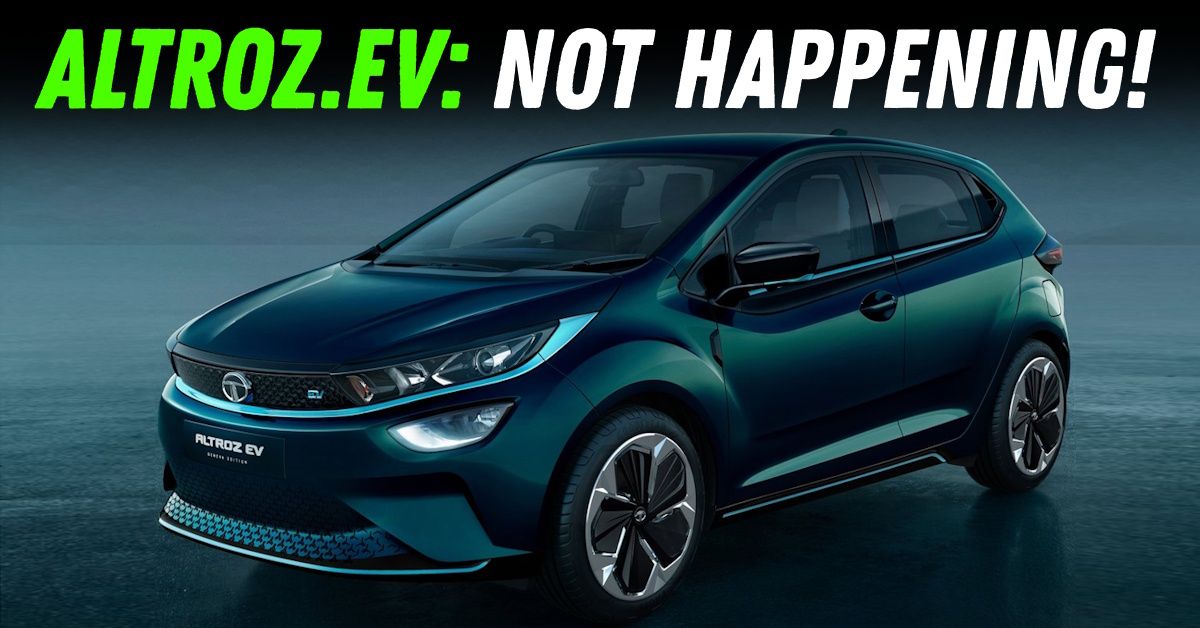Tata Altroz Electric NOT Happening: We Explain Why!


Tata Motors has officially paused its much-awaited Altroz EV project, leaving thousands of potential buyers disappointed and industry watchers questioning the future of electric hatchbacks in the country. The decision comes despite years of development work and multiple showcases at auto exhibitions, revealing deeper challenges that go far beyond simple market timing.
The Altroz EV's journey hit its biggest roadblock with a seemingly simple issue that proved nearly impossible to solve: where to put the battery. Unlike SUVs that sit higher off the ground, the Altroz's low-slung hatchback design created a packaging nightmare that engineers couldn't crack without major compromises.
The root problem lies in the Altroz's ground clearance of just 165mm. When Tata's engineers tried to mount the battery pack underneath the floor, it reduced the already modest ground clearance by around 20 mm to a dismal 145 mm. For perspective, that's lower than most cars can handle on typical roads with speed breakers and potholes.
The obvious solution - raising the entire car higher - wasn't viable either. Lifting the Altroz would completely destroy its sleek hatchback proportions and make it look like an awkward crossover. Tata's design team refused to compromise the car's visual appeal, which forms a core part of its premium positioning.
The alternative approach of pushing the battery pack higher into the cabin floor created an even worse problem. This intrusion would have made the rear seats uncomfortable for passengers, essentially defeating the purpose of having a practical family hatchback. Engineers also considered using a thinner battery pack, but this would have drastically reduced the car's range, making it barely different from the smaller Tiago EV.
Beyond technical hurdles, Tata Motors faced a strategic dilemma about where exactly the Altroz EV would fit in their expanding electric lineup. Shailesh Chandra, Managing Director of Tata Motors Passenger Vehicle Ltd, admitted that the company already had three models covering the ₹8-15 lakh segment: the Tiago EV, Punch EV, and Nexon EV.
The Altroz EV was originally planned for the ₹5-8 lakh bracket, but changing battery costs and market dynamics pushed its expected price higher. This created an uncomfortable overlap with existing products, particularly the Tiago EV, which offers similar practicality at a lower price point.
With the Tiago EV starting at ₹7.99 lakh and offering up to 315km range, and the Punch EV providing SUV appeal from ₹9.99 lakh, the Altroz EV struggled to carve out a distinct identity. The expected specifications showed it would likely offer around 320 km claimed range with a 28 kWh battery pack, barely improving on what customers could already buy.
The Altroz EV's pause reflects a broader shift in buyer preferences that's reshaping the entire automotive landscape. Hatchbacks have seen their market share drop from 35.1% to just 30% in the first half of the current fiscal year, while SUVs have surged to capture 48.3% of all vehicle sales.
This trend is particularly pronounced in the electric vehicle segment, where SUVs offer significant advantages for battery packaging. The higher ride height and larger floor space in compact SUVs like the Punch EV make it far easier to accommodate battery packs without compromising ground clearance or passenger comfort.
Several factors are driving buyers away from hatchbacks: increased disposable income, safety perceptions favouring larger vehicles, and simple crowd psychology where SUVs are seen as more desirable. In the EV space, these preferences become even more pronounced because the technology is still developing and buyers want the most practical and future-proof option available.
Rather than completely scrapping the project, Tata Motors has chosen to pause it indefinitely. Chandra indicated that if market conditions change or if there's sufficient demand in the future, the company could revive the Altroz EV plans. This suggests the technical challenges aren't insurmountable, but the business case simply doesn't stack up right now.
The decision appears particularly wise given Tata's dominant position in the electric vehicle market, where they need to avoid cannibalising their own successful products. With the Punch EV already performing well and the upcoming Curvv EV set to enter the premium electric SUV segment, adding an Altroz EV might have created more confusion than value for customers.
For buyers who were eagerly waiting for an electric version of the popular Altroz, this news undoubtedly comes as a disappointment. However, Tata's existing EV lineup offers compelling alternatives that address most of the same needs, often with better practicality and future-proofing. The pause on the Altroz EV ultimately reflects the harsh realities of engineering electric vehicles within the constraints of older platform designs.